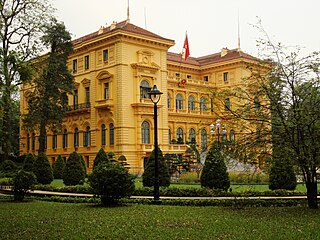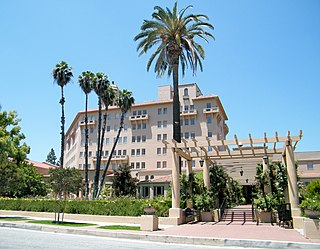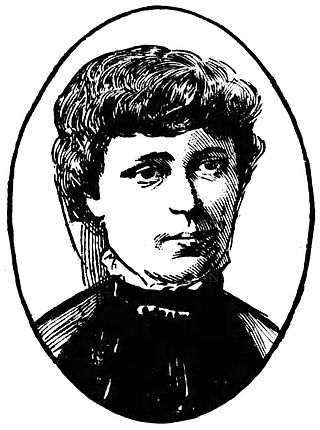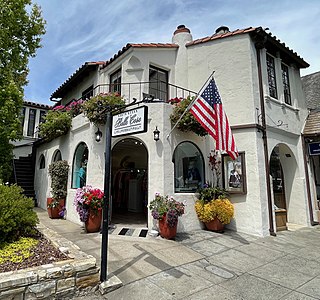
The Spanish Colonial Revival Style is an architectural stylistic movement arising in the early 20th century based on the Spanish Colonial architecture of the Spanish colonization of the Americas.

The Broadmoor is a hotel and resort in the Broadmoor neighborhood of Colorado Springs, Colorado. The Broadmoor is a member of Historic Hotels of America of the National Trust for Historic Preservation. Its visitors have included heads of state, celebrities, and professional sports stars. It is owned by The Anschutz Corporation through its subsidiary, The Broadmoor-Sea Island Company.

French colonial architecture includes several styles of architecture used by the French during colonization. Many former French colonies, especially those in Southeast Asia, have previously been reluctant to promote their colonial architecture as an asset for tourism; however, in recent times, the new generation of local authorities has somewhat "embraced" the architecture and has begun to advertise it. French Colonial architecture has a long history, beginning in North America in 1604 and being most active in the Western Hemisphere until the 19th century, when the French turned their attention more to Africa, Asia, and the Pacific.

The buildings and architecture of New Orleans reflect its history and multicultural heritage, from Creole cottages to historic mansions on St. Charles Avenue, from the balconies of the French Quarter to an Egyptian Revival U.S. Customs building and a rare example of a Moorish revival church.

The Conde–Charlotte House, also known as the Kirkbride House, is a historic house museum in Mobile, Alabama. The earliest section of the building, the rear kitchen wing, was built in 1822. The main section of the house was added a few decades later and is two and a half floors. The entire structure is constructed of handmade brick with a smooth stucco plaster over the exterior.

The Adamson House and its associated land, which was known as Vaquero Hill in the 19th century, is a historic house built by Rhoda Adamson and gardens in Malibu, California. The residence and estate is on the coast, within Malibu Lagoon State Beach park.

The Richard H. Chambers U.S. Court of Appeals is a historic building originally constructed as a Spanish Colonial Revival style resort known as the Vista del Arroyo Hotel and Bungalows located at Pasadena in Los Angeles County, California. During World War II, it served as the McCornack General Hospital, and was thereafter in use as a general-purpose federal government building for several decades. It now serves as a courthouse of the United States Court of Appeals for the Ninth Circuit.
In the United States, the National Register of Historic Places classifies its listings by various types of architecture. Listed properties often are given one or more of 40 standard architectural style classifications that appear in the National Register Information System (NRIS) database. Other properties are given a custom architectural description with "vernacular" or other qualifiers, and others have no style classification. Many National Register-listed properties do not fit into the several categories listed here, or they fit into more specialized subcategories.

The Mission Revival style was part of an architectural movement, beginning in the late 19th century, for the revival and reinterpretation of American colonial styles. Mission Revival drew inspiration from the late 18th and early 19th century Spanish missions in California. It is sometimes termed California Mission Revival, particularly when used elsewhere, such as in New Mexico and Texas which have their own unique regional architectural styles. In Australia, the style is known as Spanish Mission.
Richard Smith Requa was an American architect, largely known for his work in San Diego, California. Requa was the Master Architect for the California Pacific International Exposition held in Balboa Park in 1935–36. He improved and extended many of the already existing buildings from an earlier exposition, as well as creating new facilities including the Old Globe Theater.
Albert E. Carlton or Bert Carlton was an investor in Colorado banks, mines and railroads. Based upon the success of his mines in Cripple Creek, he was known as "King of Cripple Creek".

Tracy Park is a historic neighborhood in Tulsa, Oklahoma. It is a relatively small neighborhood consisting primarily of single-family houses that were built in the Riverview Addition during the early 1920s. The Tracy Park Historic District was added to the National Register of Historic Places on September 20, 1982 with the NRIS number 82003707. The district is bounded on the north by 11th Street, on the east by Peoria Avenue, and on the south and west by the Inner Dispersal Loop. It was the first area in Tulsa to be nominated as a district on the National Register of Historic Places.

The Arizona Inn is a hotel in Tucson, Arizona. It was built in 1930–31 by Isabella Greenway, who became Arizona's first female representative to the U.S. Congress in 1932. The Spanish Colonial Revival main building was designed by Tucson architect Merritt Starkweather. The entire 14-acre (5.7 ha) complex comprises 25 structures, of which 21 contribute to the historic district. The buildings are pink stuccoed masonry structures with blue details, arranged in landscaped gardens with more pink stucco walls. The gardens were designed by landscape architect James Oliphant. Small structures surround the gardens, which are mainly landscaped with native Arizona plants.

Emily Elizabeth Holman, better known by her professional name of E. E. Holman, was one of the first female architects of Pennsylvania. She was active from the 1880s to her retirement in 1914 and was responsible for planning several important historical sites like the Goold House in the Wilder Village Historic District, Wilder, Vermont and the National Park Seminary among many others.

The Kocher Building, also known as La Giralda is a two-story steel and concrete framed Spanish Eclectic style commercial building in Carmel-by-the-Sea, California. It was designated as an important commercial building in the city's Downtown Historic District Property Survey, on September 4, 2002. The building is occupied by La Bicyclette Restaurant on the ground floor.

The Bernard Wetzel Building is a historic commercial building in downtown Carmel-by-the-Sea, California. It is an example of Spanish Eclectic Revival style architecture. The building qualified as an important building in the city's downtown historic district property survey and was registered with the California Register of Historical Resources on September 7, 2004. The building has been occupied by Whittakers since 1989.

T.A. Oakes Building, is a historic commercial building in Carmel-by-the-Sea, California. It was built in 1922, by builder Thomas A. Oakes and designed by architect Thomas W. Morgan for a new Post Office and City Hall. It is an example of Western false front and Spanish Colonial Revival architecture styles. The building qualifies as an important building in the city's downtown historic district property survey and was recorded with the California Register of Historical Resources on October 28, 2002.

The Fee Building, is a historic commercial building in Carmel-by-the-Sea, California. It was built and designed in 1935, by master builder Michael J. Murphy as a mixed-use retail shop and residence. It is an example of a Spanish Colonial Revival architecture style building. The structure is recognized as an important commercial building in the city's Downtown Conservation District Historic Property Survey, and was nominated and submitted to the California Register of Historical Resources on February 21, 2003. The building is now occupied by the Coldwell Banker real estate agency and the Belle Cose clothing and jewelry store.

The Doud Building, also known as the James Doud Building is a historic commercial building in Carmel-by-the-Sea, California. James Cooper Doud established the building in 1932, built by master builder Michael J. Murphy as a mixed-use retail shop and residence. It is an example of a Spanish Colonial Revival architecture style building. The structure is recognized as an important commercial building in the city's Downtown Conservation District Historic Property Survey, and was nominated and submitted to the California Register of Historical Resources on February 21, 2003. The building is now occupied by the Mad Dogs & Englishmen Bike Shop and the Carmel Sport clothing store.

The Draper Leidig Building, also known as the Leidig Building, is a historic mixed-use commercial building in Carmel-by-the-Sea, California. It was designed by Blaine & Olsen and built in 1929, by C. H. Lawrence. It is an example of Spanish Revival style. The structure is recognized as an important commercial building in the city's Downtown Conservation District Historic Property Survey, and was nominated and submitted to the California Register of Historical Resources on May 22, 2002. The building is occupied by four shops, Photography West Gallery, La Renaissance Jewelry, Caraccioli Cellars, and Girl Lee Boutique.



















